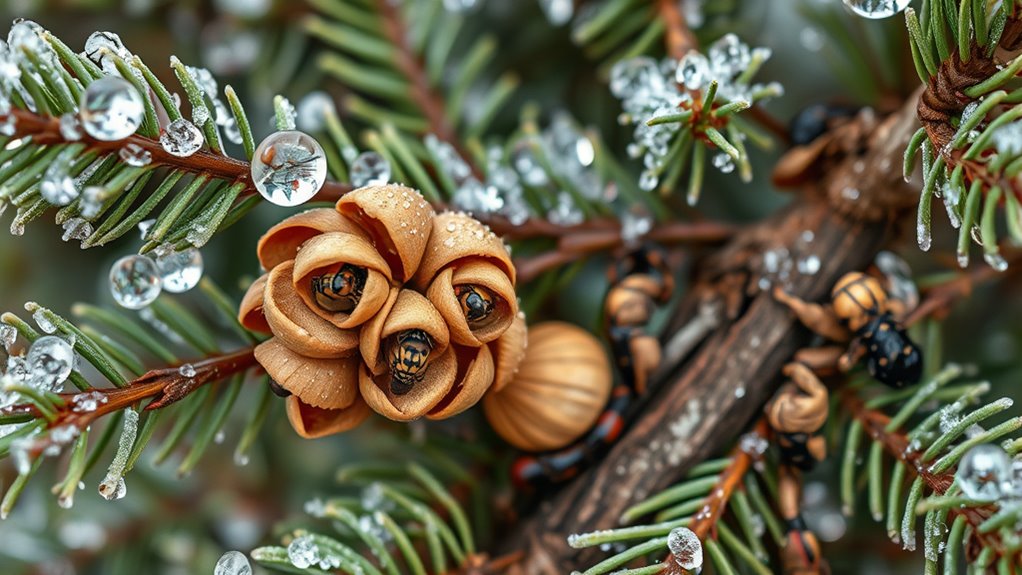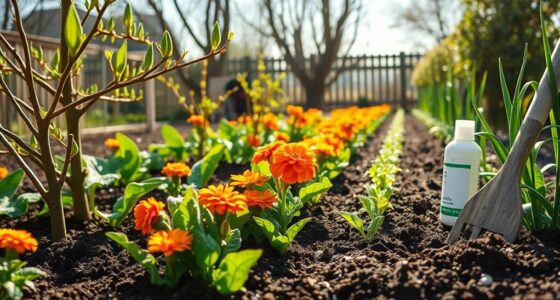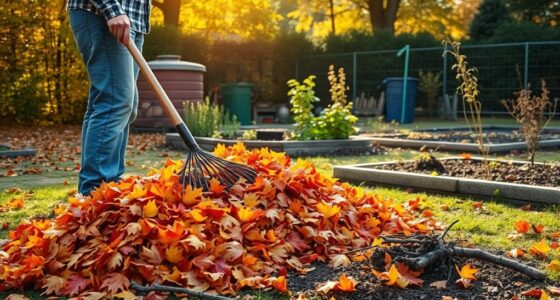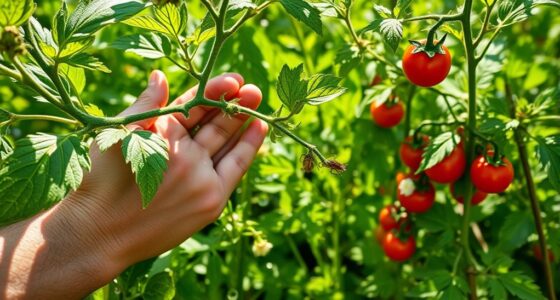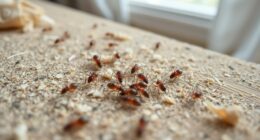To detect overwintering pests in your winter garden, regularly inspect plants, focusing on undersides of leaves, curled stems, and hidden debris where pests hide. Use tools like magnifying glasses, sticky traps, and soil moisture meters to spot tiny insects or egg deposits. Check soil surfaces and pruning deadwood to find signs of pests. Consistent monitoring and proactive sanitation help keep pests in check—continue exploring to discover more effective detection tips.
Key Takeaways
- Conduct regular inspections of plants, focusing on leaf undersides, stems, and sheltered areas for pest signs like webbing or damage.
- Use magnifying tools and sticky traps to detect tiny pests or eggs hidden on plant surfaces or soil debris.
- Monitor environmental conditions with thermometers and humidity gauges to identify factors that promote pest overwintering.
- Clear debris and perform dormant pruning to remove potential pest habitats and improve visibility during inspections.
- Record pest activity patterns throughout winter to inform targeted interventions and improve overall pest management strategies.
Identifying Common Overwintering Pests in Winter Gardens

Have you ever wondered which pests might be lurking in your winter garden during the colder months? Early detection is key, so start with caterpillar identification. Look for tiny, camouflaged larvae on the undersides of leaves or curled plant parts. These pests can cause damage even in winter, especially if your plants are still actively growing. Additionally, emphasize aphid monitoring; these small, soft-bodied insects often hide in dense foliage or near new growth. They tend to cluster in colonies, making them easier to spot if you pay close attention. Recognizing these common overwintering pests early helps you take swift action to prevent infestations from worsening come spring. Regular inspections are your best defense for maintaining a healthy, pest-free winter garden. Proper pest identification allows for more effective control measures and healthier plants year-round.
Essential Tools for Winter Garden Monitoring

To effectively monitor your winter garden, you need the right tools to spot pests early and assess plant health. A good magnifying glass or hand lens helps you closely examine plant surfaces for signs of overwintering pests or damage. Sticky traps are essential for catching crawling or flying pests, aiding in winter pest prevention. A pruning shear allows you to remove infested or dead plant parts, supporting garden maintenance. A thermometer and humidity gauge help you monitor environmental conditions that influence pest activity. Using these tools consistently guarantees you detect issues early, preventing infestations from spreading. Proper monitoring with these tools also helps you develop targeted pest prevention strategies, keeping your winter garden healthy and thriving despite the cold months. Regular inspection with air quality monitoring tools can further assist in maintaining optimal conditions for plant health.
Recognizing Signs of Pest Activity During Cold Months

During the cold months, keep an eye out for visible pest damage on your plants, such as chewed leaves or broken stems. You should also stay alert for unusual odors near your garden, which can indicate pest presence. Recognizing these signs early helps you take action before pests cause more harm.
Visible Pest Damage
Even in the cold months, pests can leave noticeable marks on your winter garden. You might notice damaged or discolored leaves, especially in colorful foliage plants that stand out even in winter. Pests often cause visible holes, chewed edges, or sticky residues on the plant surfaces. Frost damage can also mimic pest activity, with tissue browning or blackening appearing on leaves and stems. Look closely for signs of insects or their webbing, especially on the undersides of leaves or in hidden crevices. While frost damage is a natural response to cold, pest activity often leaves irregular patterns or localized damage that’s distinct from frost effects. Recognizing these signs helps you identify pest presence early and take appropriate action. Additionally, textile line patterns in plant damage can sometimes help differentiate pest activity from other environmental stressors.
Unusual Odor Detection
Unusual odors can be key indicators of pest activity in your winter garden, even when visual signs are hard to spot. Detecting these scents helps you identify pest presence early. To do this effectively, focus on odor source identification by carefully noting where the smell originates. Use scent detection techniques, such as close inspection or sniffing near suspect areas, to pinpoint the source. Additionally, understanding odor control methods can aid in managing and mitigating pest-related smells in your garden. Here’s how to proceed:
- Trace the strongest odor to locate the pest hiding spot.
- Differentiate pest-related odors from plant or decay smells.
- Document unusual smells for future reference or expert consultation.
Best Practices for Inspecting Soil and Plant Debris
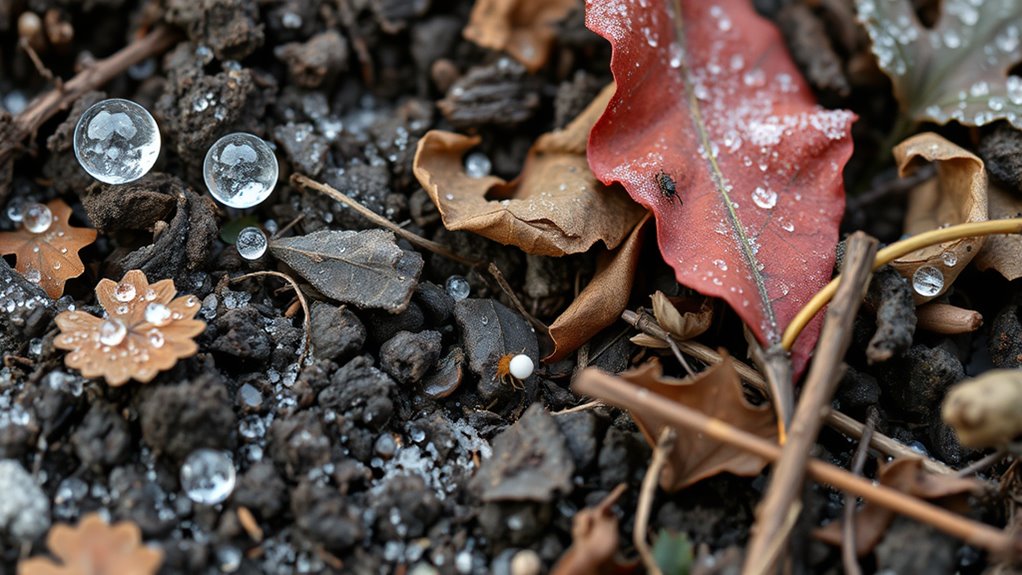
To keep your winter garden healthy, start by checking soil moisture levels to prevent over- or under-watering. Clear away leaf and plant debris regularly, as it can harbor pests or diseases. Also, look closely for any signs of pest activity on soil or debris to catch problems early. Be aware that some pests can hide within plant debris or soil, making regular inspection essential for effective pest detection and management.
Examine Soil Moisture Levels
Inspecting soil moisture levels is a vital step in winter garden monitoring because it helps guarantee plants receive the right amount of water during the colder months. Proper moisture prevents soil compaction, which can hinder root growth and pest movement. To assess moisture:
- Use a soil moisture meter to get an accurate reading at different depths.
- Check for uneven wetness that might indicate poor drainage or compaction.
- Observe if dry patches coincide with signs of nutrient deficiencies, as dry soil limits nutrient uptake.
Maintaining ideal moisture levels reduces stress on plants and minimizes pest overwintering risks. It also helps identify areas needing soil aeration or amendment, ensuring the soil’s structure remains healthy and supportive during winter. Proper moisture management is key to a resilient winter garden.
Clear Leaf and Plant Debris
Ever wonder why clearing leaf and plant debris is essential for winter garden health? Removing fallen leaves and plant debris prevents pests and diseases from overwintering in your garden. As part of mulch layering, debris can trap moisture and create a haven for pests, so clearing it reduces these risks. Proper compost management also plays a role; compost piles should be turned and monitored regularly to prevent pest buildup. Avoid leaving thick layers of debris directly on the soil, as they can harbor overwintering pests. Instead, clear and compost or remove organic matter to improve soil aeration and reduce pest habitats. Keeping your garden tidy ensures a healthier spring start and minimizes pest problems when the growing season resumes. Incorporating good lighting and ensuring good airflow can further deter overwintering pests and promote a healthy garden environment.
Check for Pest Signs
Checking your soil and plant debris for pest signs is a critical step in maintaining winter garden health. Start by examining the soil surface for unusual markings or pests hiding beneath the debris. Next, loosen compacted soil gently to reveal hidden pests and assess soil health. Finally, inspect plant debris for eggs, larvae, or damage caused by pests, paying attention to areas near roots or stems. During this process, address soil compaction by aerating if needed, and prune any infested or dead plant material to prevent pest spread. Regularly checking these areas helps catch overwintering pests early, reducing the risk of infestations when the growing season resumes. Understanding electric bike concepts can also inspire eco-friendly practices in your garden routines. Staying vigilant ensures your garden remains healthy and pest-free throughout winter.
Monitoring Trees and Shrubs for Hidden Pests

Since hidden pests often evade casual observation, diligent monitoring of trees and shrubs is essential during winter. Check for subtle signs like abnormal buds, discolored leaves, or unusual growth. Look closely at the branches for tiny insects or webbing. Incorporate dormant pruning to remove infested or dead wood, which can hide pests. Proper winter watering helps keep plants healthy and resilient. Use the table below to guide your inspection:
| Action | Signs to Watch For | Timing |
|---|---|---|
| Dormant pruning | Dead or infested branches | Late winter, before bud break |
| Visual inspection | Discoloration, webbing, small pests | Monthly during winter |
| Watering | Dry soil, stressed plants | As needed during cold spells |
Regular checks ensure you catch pests early, preventing infestations.
Techniques for Using Traps and Baits Effectively

Using traps and baits effectively is essential for detecting and managing pests during winter when they often hide in concealed locations. To maximize their effectiveness, focus on three key steps:
Effective winter pest detection relies on strategic trap use and regular monitoring.
- Trap selection: Choose traps suited to the pest you’re targeting, such as sticky traps for flying insects or pheromone traps for specific species.
- Bait placement: Position baits where pests are likely to travel or hide, such as near entry points or along pathways. Ensure they’re at the right height and away from competing scents.
- Regular monitoring: Check traps frequently, replacing baits as needed and recording pest activity. Proper trap selection combined with strategic bait placement helps you catch overwintering pests early and prevent infestations.
- Additionally, understanding the best time for monitoring can improve your chances of early detection and effective pest control.
Timing and Frequency of Winter Inspections
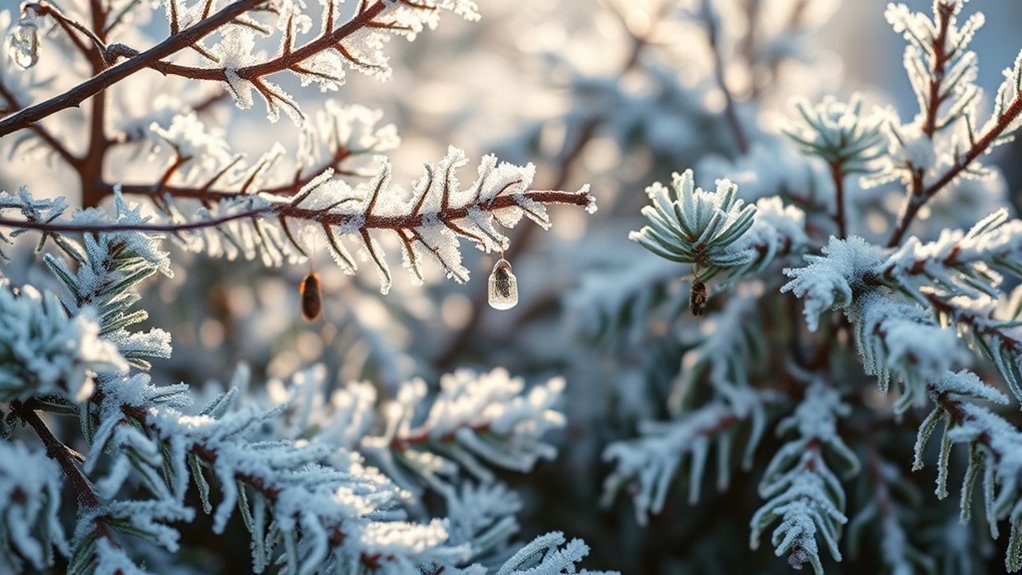
Timing and frequency of winter inspections are critical for early pest detection and management, as pests often remain hidden during colder months. Pests exhibit seasonal pest behavior, becoming less active but still overwintering in sheltered areas. Regular inspections help you identify signs of pests early, reducing damage and preventing infestations. During winter garden sanitation, remove debris and prune dead plant material to limit hiding spots. Conduct inspections more frequently in areas prone to pest activity, such as corners and underneath plant canopies. Use this table to guide your schedule:
| Inspection Frequency | Key Focus Areas |
|---|---|
| Weekly | Hidden spots, plant bases |
| Biweekly | Entry points, winter shelter sites |
| Monthly | Overall sanitation, debris buildup |
Consistent inspections ensure you stay ahead of seasonal pest behavior. Maintaining garden cleanliness can significantly reduce overwintering pest populations.
Developing a Year-Round Pest Management Plan
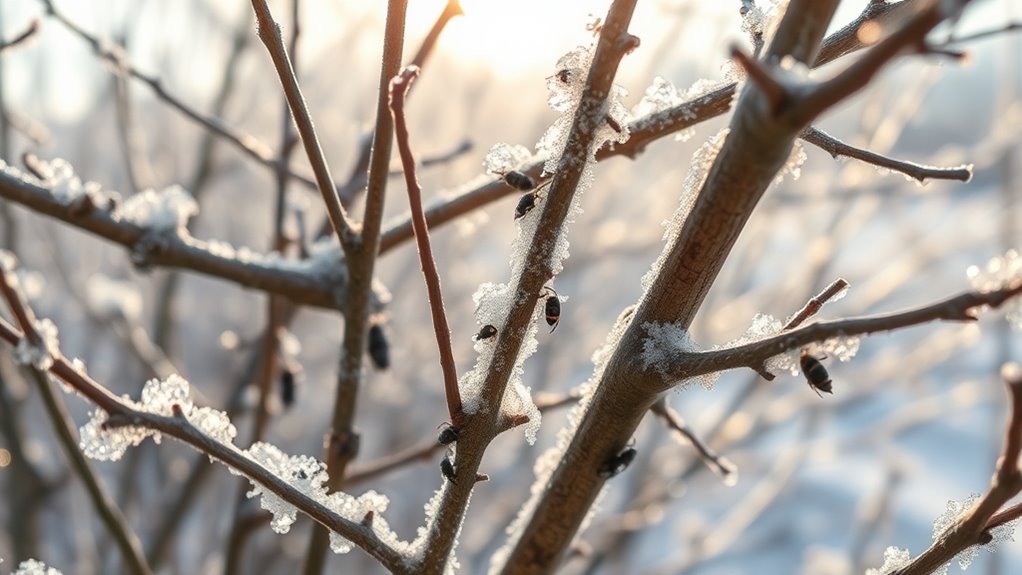
A thorough year-round pest management plan is essential for maintaining a healthy garden throughout all seasons. Understanding seasonal pest behaviors helps you anticipate and prevent infestations. To do this effectively, consider these steps:
- Monitor pests during different seasons to identify patterns and vulnerable times.
- Incorporate pest-resistant plant varieties to reduce the likelihood of infestations.
- Adjust your pest control strategies based on seasonal changes and pest activity.
- Utilizing knowledge about pest behavior patterns can improve the timing and effectiveness of your interventions.
Frequently Asked Questions
How Do Weather Conditions Affect Pest Activity in Winter Gardens?
You should know that weather conditions greatly influence pest activity in winter gardens. Microclimate effects, like sheltered spots or heated areas, can create warmer pockets that pests favor. Temperature fluctuations, especially sudden drops, can either suppress or trigger pest activity by prompting pests to seek shelter or become active. Monitoring these conditions helps you anticipate pest behavior, so you can take timely action to protect your garden.
Can Indoor Plants Harbor Overwintering Pests?
You might wonder if indoor plants can harbor overwintering pests, and evidence suggests they often do. Indoor pest hiding occurs when pests find cozy spots in plant dormancy signals, like leaf curl or yellowing, making them hard to spot. These pests can stay dormant through winter, only to emerge when conditions improve. Regular inspection is key to catching these hidden invaders early before they spread.
Are There Eco-Friendly Methods for Winter Pest Control?
You can use eco-friendly methods like biological controls and natural repellents for winter pest control. Biological controls involve introducing beneficial insects or microbes that target pests without chemicals. Natural repellents, such as neem oil or garlic spray, deter pests safely. These methods are effective, environmentally friendly, and help protect your garden during winter, reducing reliance on harmful pesticides. Give them a try to keep your plants healthy and pest-free sustainably.
How Do I Differentiate Between Pest Damage and Weather-Related Plant Stress?
Imagine your garden’s leaves, some showing spots, others wilting, like a weathered map. To differentiate pest damage from weather stress, focus on plant symptom differentiation: pest damage often shows irregular holes, webbing, or visible insects, while weather stress causes uniform discoloration or leaf scorch. Observe patterns closely—pests tend to target specific areas, whereas weather impacts are more widespread. Recognizing these signs helps you identify whether pests or environmental factors cause the damage.
What Are Common Mistakes to Avoid During Winter Pest Inspections?
When inspecting for pests in winter, avoid timing inaccuracies by checking plants at ideal times, like early morning or late afternoon. Don’t neglect moisture, as damp conditions can hide pest activity or damage. Rushing through inspections or overlooking hidden spots can lead to missed signs. Stay thorough, pay attention to moisture levels, and keep a consistent schedule to guarantee you catch overwintering pests before they spread.
Conclusion
Think of your winter garden as a fortress, needing vigilant guards to spot hidden invaders. Regular monitoring helps you catch overwintering pests before they can cause damage. By staying attentive and using the right tools, you keep your garden safe and healthy through the cold months. Remember, your watchful eye is the lighthouse guiding your garden safely through winter’s darkness, ensuring it blooms beautifully when spring arrives.
